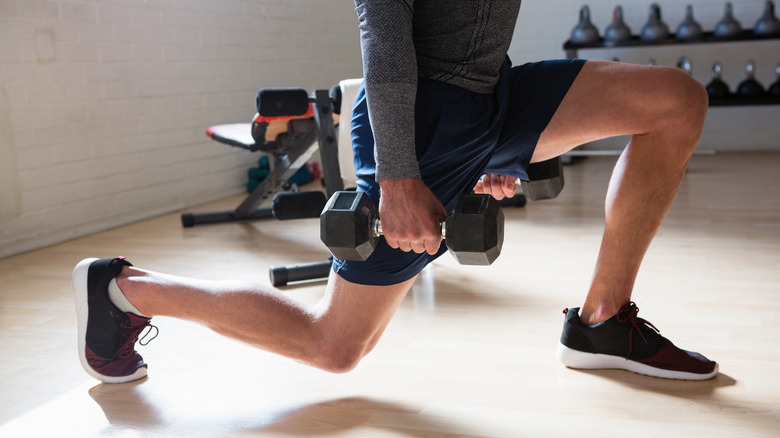Is Getting 10,000 Steps A Day Really Necessary? A Doctor Weighs In
Americans with fitness trackers are often aiming to take 10,000 steps a day, even if it means getting up to move around in the midst of a work day or while watching TV. Though this has long been the recommended number of steps to take in a day, is that many steps really necessary? Health Digest got the scoop in an exclusive chat with Dr. Kathy Weber, a sports medicine physician at Midwest Orthopaedics at Rush and an official physician for the Chicago Bulls and Chicago White Sox.
While taking steps might feel too easy to actually be good for us, getting enough steps in a day can have far-reaching effects, according to Dr. Weber. "The benefit of engaging in a step program includes improved muscle tone, maintaining weight or weight loss, reducing body fat, and improving blood sugar control," she shared. And that's not all. "Regular aerobic activity such as daily steps can help reduce your risk of common health problems such as heart disease, obesity, and diabetes."
Depending on how big your steps are, taking 10,000 steps is about the equivalent of 4-5 miles. "Steps can range in intensity from light, moderate, or vigorous, allowing for a range of step speed from a slow walk to running, depending on the individual's physical condition," said Dr. Weber. Each mile that we walk, we burn calories. The amount we burn depends on how much we weigh, but generally, walking one mile burns about 100 calories.
Here's how much exercise you should really focus on
Dr. Weber explained, "If your goal is to lose weight, you will need to expend 3,500 calories more than you consume to lose one pound." But that might not be the way to do it. "However," she said, "the healthiest way to maintain or lose weight is a combination of healthy eating and activity, such as steps."
But, Dr. Weber said that it's not really necessary to hit 10,000 steps every day — with a caveat. "Activity is necessary," she stipulated. "The ACSM (American College of Sports Medicine), CDC (Centers for Disease Control and Prevention), and the U.S. Department of Health and Human Services recommend at a minimum 150 minutes a week of moderate-intensity exercise," Dr. Weber said. That breaks down to about 30 minutes of activity five times per week. "Their recommendations can be achieved by brisk walking through steps, but also by a variety of other aerobic activities that raise your heart rate."
But you don't want to overdo the aerobic activity. You could also add in two non-consecutive days of strength training, which Dr. Weber said the ACSM recommends. "Depending on the physical condition of the individual, too many steps could lead to overuse injuries, such as muscle strains, tendinitis, and stress fractures."
Adding a step regimen to your routine
If you've been wanting to improve your health or try to lose weight, don't go too hard too fast. Dr. Weber exclusively told Health Digest, "No matter your age, a step program should be started slowly, incorporating rest days while gradually increasing your daily steps, so your body can adapt to the increased activity." But it's always smart to talk to your doctor before starting a new exercise routine, even if it's just a step program. "Commonly as we age, we may develop issues such as knee or hip arthritis that make walking more difficult or limit the number of steps that one can or should do," Dr. Weber explained. "Other health issues such as obesity, cardiac, or pulmonary conditions may also affect the step goal."
If you decide to add in more activity where you can, there are some simple adjustments you can make to get more steps in your day. Try parking further away from your destination in the parking lot, walking the dog more often, choosing the stairs instead of the elevator when possible, including the family in a hike or group activity, and walking around instead of sitting to wait for something like a flight or appointment.
Things to keep in mind when working to achieve your goal
There are a few things that Dr. Weber commonly sees that you should keep in mind when trying to implement a new exercise practice. She exclusively told Health Digest, "Adaptation to the increasing activity is often overlooked and can result in injuries." If your body isn't used to exercising at the intensity and frequency you're trying to achieve, you might need to be patient while your body adjusts. "Remember that our bodies need time to adapt to the exercise so that we don't get sidelined by an injury," Dr. Weber said.
One way that Dr. Weber suggests reducing your risk of injury is by adding strength training. "The most overlooked issue I see in my patients and in many in the community is the lack of incorporating muscle strengthening," she shared. "Although upper extremity strengthening is needed, the importance of a lower extremity strength program cannot be overemphasized." Strengthening your legs can "contribute to better balance and may help prevent injury, protect the bones and joints, and prevent falls," Dr. Weber said.




